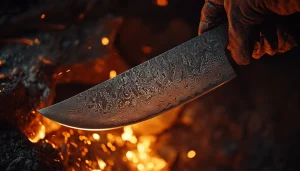As a home chef, stepping into your kitchen can feel like stepping onto a stage. The tools you use, especially your knives, are key to making the cooking process enjoyable and efficient. But with so many options out there, it can be overwhelming to know which essential knives for a chef you need.
In this guide, we’ll walk you through everything you need to know about chef knives and help answer the question: “What chef knives do I need?”
Why Are Knives So Important in the Kitchen?
Before diving into the specific knives you’ll want to have in your kitchen, it’s worth understanding why having the right knives is so important. Knives are the backbone of food prep. Whether you’re chopping vegetables, slicing meat, or mincing garlic, the right knife can make all the difference in terms of speed, precision, and safety. A dull or inappropriate knife can not only slow you down but also increase the risk of accidents.
What Chef Knives Do I Need? The Essential Set for Home Chefs
To become a more efficient home chef, you don’t need a massive arsenal of knives, but you do need a few essentials. Here’s a rundown of the core knives every home cook should have in their kitchen:
1. The Chef’s Knife: Your Kitchen Workhorse
The chef’s knife is the most versatile and arguably the most important knife in your collection. Whether you’re a seasoned home chef or just starting, this is the knife you’ll reach for most often.
Key Features:
- Length: Typically between 6 and 12 inches
- Blade Shape: Curved, allowing a rocking motion for chopping and slicing
- Ideal For: Chopping vegetables, slicing meat, and dicing herbs
Why You Need It: The chef’s knife is perfect for nearly all cutting tasks. It’s robust enough for tough jobs like cutting through squash or meat, but also precise enough for delicate tasks like mincing garlic or slicing herbs. Invest in a good-quality chef’s knife, and it will be your best friend in the kitchen.
2. Paring Knife: Small but Mighty
The paring knife is another must-have in the kitchen, designed for smaller, more intricate tasks that require precision.
Key Features:
- Length: 3 to 4 inches
- Blade Shape: Short and sharp, typically straight or slightly curved
- Ideal For: Peeling fruits and vegetables, trimming fat, and making precise cuts
Why You Need It: The paring knife is perfect for those delicate jobs where a chef’s knife is just too big. From peeling apples to deveining shrimp, the paring knife is your go-to for smaller, more detailed tasks.
3. Serrated Bread Knife: For More Than Just Bread
Though it’s often referred to as a bread knife, this serrated knife has more uses than you might think.
Key Features:
- Length: 8 to 10 inches
- Blade Shape: Long and straight with a serrated edge
- Ideal For: Slicing through crusty bread, tomatoes, or anything with a tough exterior and soft interior
Why You Need It: The serrated edge is perfect for cutting through bread without crushing it, but it’s also great for soft fruits like tomatoes and citrus. A serrated bread knife can handle any food that’s firm on the outside but tender inside, making it more versatile than its name suggests.
4. Utility Knife: The In-Between Workhorse
Somewhere between a chef’s knife and a paring knife lies the utility knife. It’s great for those times when a paring knife feels too small, but a chef’s knife feels like overkill.
Key Features:
- Length: 4 to 6 inches
- Blade Shape: Similar to a chef’s knife but smaller and narrower
- Ideal For: Slicing sandwiches, trimming fat, and cutting medium-sized fruits and vegetables
Why You Need It: The utility knife is a great all-rounder that can handle a variety of kitchen tasks, especially when working with medium-sized ingredients. It’s a handy backup to your chef’s knife.
5. Boning Knife: A Must for Meat Lovers
If you work with meat often, a boning knife is a great addition to your collection. This knife is designed to get right into the joints and bones, making it easier to break down cuts of meat.
Key Features:
- Length: 5 to 7 inches
- Blade Shape: Narrow and flexible, with a pointed tip
- Ideal For: Removing bones from chicken, fish, or beef; trimming fat
Why You Need It: If you’re serious about handling meat, a boning knife allows you to make precise cuts and remove bones with ease, which can save you time and effort when working with tougher cuts of meat.
6. Carving Knife: For Perfectly Sliced Meat
If you frequently roast meats or prepare large cuts, a carving knife will come in handy. It’s designed to produce thin, even slices, making it the ideal knife for holiday dinners or Sunday roasts.
Key Features:
- Length: 8 to 12 inches
- Blade Shape: Long and narrow, with a slightly flexible blade
- Ideal For: Slicing roasts, turkey, ham, or other large cuts of meat
Why You Need It: A carving knife is essential for perfectly sliced meat, ensuring you can present a beautiful platter at the dinner table. It’s not a knife you’ll use every day, but when you need it, nothing else will do.
Other Helpful Tools for the Home Chef
While the above knives are essential for every home chef, there are a few additional tools that can make your knife collection even more versatile:
- Kitchen Shears: For cutting herbs, trimming meat, or even opening packaging.
- Honing Steel: To maintain the sharpness of your knives between uses. A sharp knife is a safe knife.
- Knife Block or Magnetic Strip: To keep your knives organized and within easy reach.
How to Choose the Right Knives for You
Now that you know what chef knives you need as a home chef, the next step is choosing the right ones. When shopping for knives, consider the following factors:
1. Blade Material: Stainless Steel vs. Carbon Steel
Most knives are made from either stainless steel or carbon steel. Stainless steel is durable, resistant to rust, and easy to maintain, while carbon steel is sharper and easier to hone but requires more care to prevent rusting.
2. Handle Comfort
The handle should feel comfortable in your hand. Some prefer a heavier, more balanced knife, while others like a lighter feel. It’s all about personal preference, so try holding a few different types before making your decision.
3. Balance
A well-balanced knife feels good in your hand and is easier to control. Test the balance by holding the knife where the blade meets the handle. If it feels too blade-heavy or handle-heavy, it might be awkward to use for extended periods.
How to Care for Your Chef Knives
Once you’ve invested in good-quality chef knives, you’ll want to make sure they last. Proper care and maintenance are key to keeping your knives sharp and in great condition.
1. Hand Wash Only
Always hand wash your knives and dry them immediately. Avoid putting them in the dishwasher, as the harsh detergents and water pressure can damage the blade and handle.
2. Sharpen Regularly
Even the best knives need to be sharpened regularly. Use a honing steel to maintain the edge between uses, and get your knives professionally sharpened a few times a year depending on how often you cook.
3. Store Properly
Don’t toss your knives into a drawer where they can get dinged up. Invest in a knife block or magnetic strip to keep your knives safe and easily accessible.
Do You Need More Than the Basics?
For most home chefs, the knives mentioned above will be more than sufficient for everyday cooking. But if you’re an enthusiast or like to experiment with different cooking techniques, there are a few other specialty knives worth considering:
- Santoku Knife: A Japanese knife similar to a chef’s knife but with a shorter, wider blade. It’s great for chopping and slicing.
- Nakiri Knife: A Japanese vegetable knife with a straight edge, perfect for clean, even cuts through veggies.
- Fillet Knife: A more flexible version of the boning knife, ideal for filleting fish.
Final Thoughts: What Chef Knives Do I Need?
At the end of the day, the knives you need as a home chef depend on what and how often you cook. If you’re preparing meals daily, investing in high-quality knives is worth it. A solid chef’s knife, paring knife, serrated bread knife, and utility knife will cover most of your bases.
Remember, it’s not about how many knives you have, but about having the right ones. Keep your collection simple and practical, and you’ll be able to tackle any recipe that comes your way.
Now, it’s time to start chopping!




